history in a jar
by Rach-the-tourist
Phonsavanh, Laos
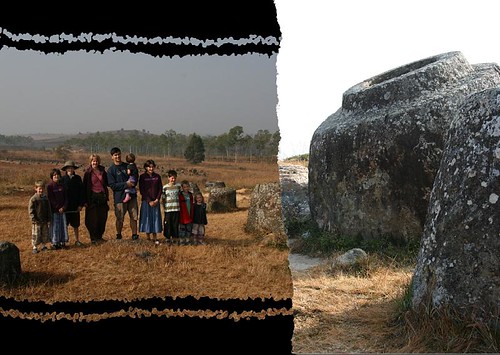
Having seen a few photos of the large stone jars for which this region is famous, I was expecting them to be bigger (6 tonnes is big, right?). But while there were a lot of them at the site we visited (334 in all), none were overly impressive sizewise. Our photos, however, did turn out well!
These great stone jars strewn about the plain are a source of mystery. No-one knows how long they’ve been there (estimates vary from 1,500 to 4,000 years), who put them there or why. Local legends suggest the mighty Khom people were victorious against every other people in the region and needed large vessels to contain their whisky, so great were their celebrations. Perhaps more believable is the idea that they were for rice storage. Even more plausible, especially given that bones and jewellery have been found under some of them, is that they were in some way used in funerary rites. A strong belief in reincarnation surely lends weight to this theory. Additionally, two years ago a visiting Chinese teacher noticed some Chinese characters on some of the jars – jars just like the ones used in his home region for funeral purposes. Hopefully he will return to shed further light on the inscriptions.
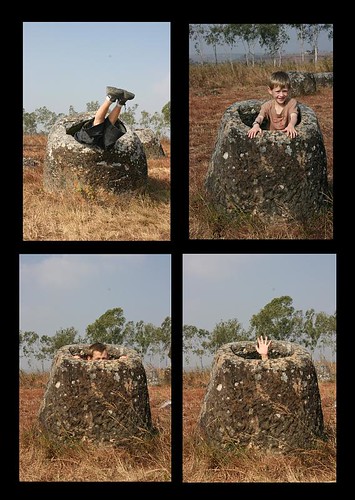

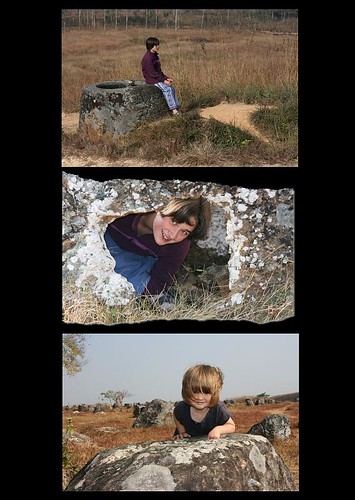
Apart from the wonder and intrigue at the jars, you come away from this area with a sense of sadness at the ongoing effects of war. From 1964 to 1973 the North Vietnamese transported huge quantities of war material through this area, prompting the US to respond with the largest bombing campaign in history. During this time Laos was the recipient of 90 million bombs, some of which were dropped merely because aircraft needed to unload before returning to base, others specifically targeting communist activities, but simultaneously harming civilians caught in the crossfire. Between 1967 and 1969 the entire population lived at night – they farmed, fished, cooked and washed after dark so as not to attract the attention of the continuous stream of daytime planes overhead. With napalm killing off much of the forest, people fled to the caves. We visited three of them – it was strange to think that as long ago as 1782 people had been coming here to worship a Buddha, and as recently as our own lifetime they had been sheltering here for dear life. Today there’s a collection of small Buddhas (as well as the big one) in one cave and medicine bottles are scattered across the floor of the “Hospital Cave”.

The “legacy” (if you can call it that) of this time remains. People today are living with birth defects. Families stayed forever broken (our guide’s grandfather sent his wife to Vientiane for safety, but she didn’t return for over seven years. He had assumed she had died and so remarried – imagine the scene when eventually she did turn up on the doorstep!) People are still being maimed and killed. UXOs (unexploded ordnances) litter the countryside, preventing families from farming, or putting them at extreme risk if they try. The Plain of Jars sites were cleared in 2004. It took three months to uncover more than 31,000 pieces of scrap and to find and destroy 127 UXOs spread across 225,000 square metres. Thankfully, it is not only tourist sites being cleared – farmland that will benefit local folk is also being made safe, but it is a slow and dangerous process. Staying inside the white and red markers through the jars site was a visible reminder of the danger faced by these people every day.
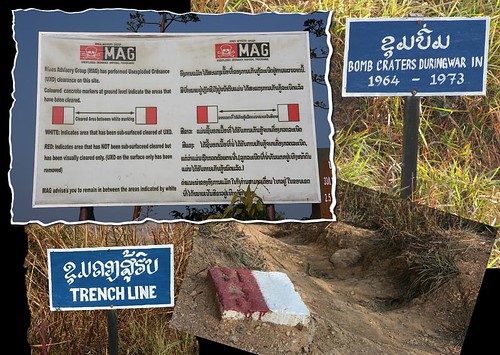
Seeing an abandoned Russian tank, buffalo shelters made out of bomb casings, an old airstrip – these all reinforced the same message.
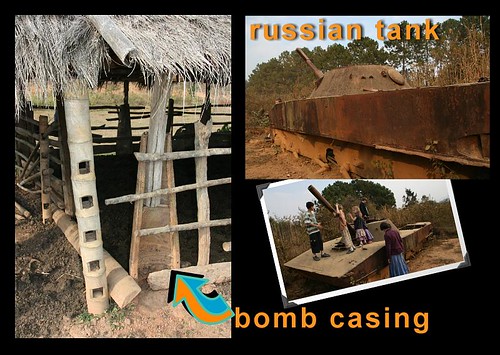
Watch this space: we’ll be putting together a photo album of our better photos from the day when we get to a good internet connection hopefully in a few days – today’s ones are just to whet your appetite!
Tags: children, history, justice, learning, postcard: Laos




another very interesting post
thanks
Hi tribe what wonderful stories and life experiences. I am so glad you enjoyed the Loi Kratong festival in CM as much as I did in 2006. I have given your website to my sick friend Gaby in Germany. She is in bed recovering from chemo, I am sure you will inspire lots of people.
I feel a bit cynical about Christmas here, went to another church and asked the young people who were decorating for the evening: do you have a nativity scene? the answer was : what is a nativity scene!!! hence my poem:
I hate Santa
there I said it
Shopping mall Santa
Buy buy Santa
Eat eat Santa
Santa the symbol for unbelievers from Beijing to Boston
what is a Nativity?
Even the young Christians don’t know
don’t know their history because we blend in with Santa
don’t know the symbols of our special history
reject them as idols
and yet they are our symbols of faith
just been discussing the raison detre for these jars with my learned brother and he has come up with the obvious solution: somebody had a hobby of jarmaking 0- and didn’t know when to stop. or was perhaps trying to make the Perfect Jar.
Sounds very reasonable to me – and he came up with this explanation in a flash!